|
What is XMM?
The X-ray Multi-Mirror
(XMM) satellite is a European Space Agency project in which the
UK is playing a leading role. The 3.9 tonne orbital observatory
will be the largest scientific satellite ever built in Europe.
It is due to be launched by the Ariane 5 rocket from Europe's
spaceport at Kourou, close to the Equator in French Guiana, in
December 1999.
|
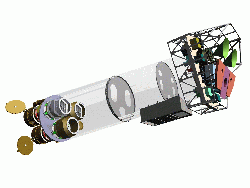 |
XMM's
payload consists of three X-ray telescopes, an optical/UV telescope
and two star trackers. Here, the X-ray telescopes can be seen
(bottom left) |
|
| The name
XMM refers to the large number of mirrors - more than any previous
X-ray observatory - the satellite will use to capture and focus
incoming X-rays. These gold-coated mirrors are shaped like barrels,
one inside the other. The smallest mirror is 30.6 cm across and
the largest measures 70 cm. |
| |
XMM
mirrors during reassembly |
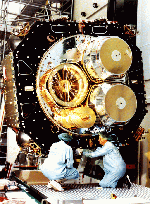 |
| Each
of XMM's three telescopes uses 58 of these 'nested' mirrors.
This complex system will make XMM the most sensitive X-ray observatory
in the world. It will be able to detect galaxies which lie only
a few thousandths of a degree apart in the sky (a full Moon is
half a degree across) - equivalent to distinguishing two footballs
lying side by side at a distance of 40 km. |
|
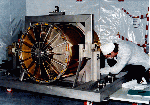 |
XMM's
curved nested mirrors will enable it to capture 60 per cent of
incoming X-rays |
|
| Incoming
X-rays will glance off the nested mirrors and be focussed at
the far end of a 10- metre-long tube where the detectors and
scientific instruments are located. The UK is involved in all
three of XMM's science instruments. |
| |
- The European Photon
Imaging Camera (EPIC) will take X-ray pictures of the sky and
study the energy of the incoming X-rays. The University of Leicester
is leading the team responsible for building the telescope, which
also includes the University of Birmingham.
|
|
| |
- Mullard Space Science
Laboratory (MSSL) in Surrey, part of University College London,
is helping to build a spectrometer to study the energy and type
of X-rays in great detail. It works by spreading the X-rays across
an array of detectors. Just as a glass prism bends and separates
light into the colours of the rainbow producing a spectrum, so
the spectrometer will bend and separate the beam of X-rays according
to their wavelength. Each chemical element gives out its own
unique set of X-ray wavelengths, so XMM will give astronomers
information about which elements are present.
|
|
| |
- MSSL is also leading
the construction of a sensitive conventional telescope called
an optical monitor (OM). This will look at the same region of
sky as the X-ray telescopes, providing images in visible and
ultraviolet light and enabling astronomers to rapidly identify
the X-ray sources.
|
|
| |
The
EPIC camera. The CCDs are in the centre, surrounded by the detector
electronics board |
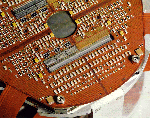 |
|
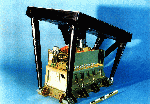 |
The
Reflection Grating Spectrometer (RGS) Focal Camera and its black
passive radiator (photons come in from the bottom). |
|
|
|
The
Optical Monitor (OM), with its baffle mounted in front, undergoing
tests. |
 |
| Astronomers
at Leicester, MSSL and Cambridge will also play a key role in
the XMM Survey Science Centre which is located in Leicester,
following up XMM's discoveries. They will compile a list of all
the new X-ray sources so that scientists can learn more about
them with ground-based optical and radio telescopes. |
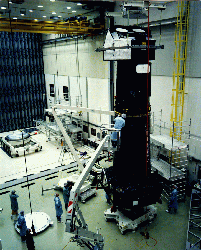 |
XMM,
which has to be taken apart for transportation, is reassembled
at the ESTEC testing site |
|
| Since
XMM will follow a highly elliptical (oval) orbit, its distance
from the Earth will vary from 7,000 km to 114,000 km. Most of
its operations will take place near the furthest point of each
orbit. This elongated path also means that XMM can stay in touch
with ground stations for 40 hours out of every 48-hour circuit. |
|